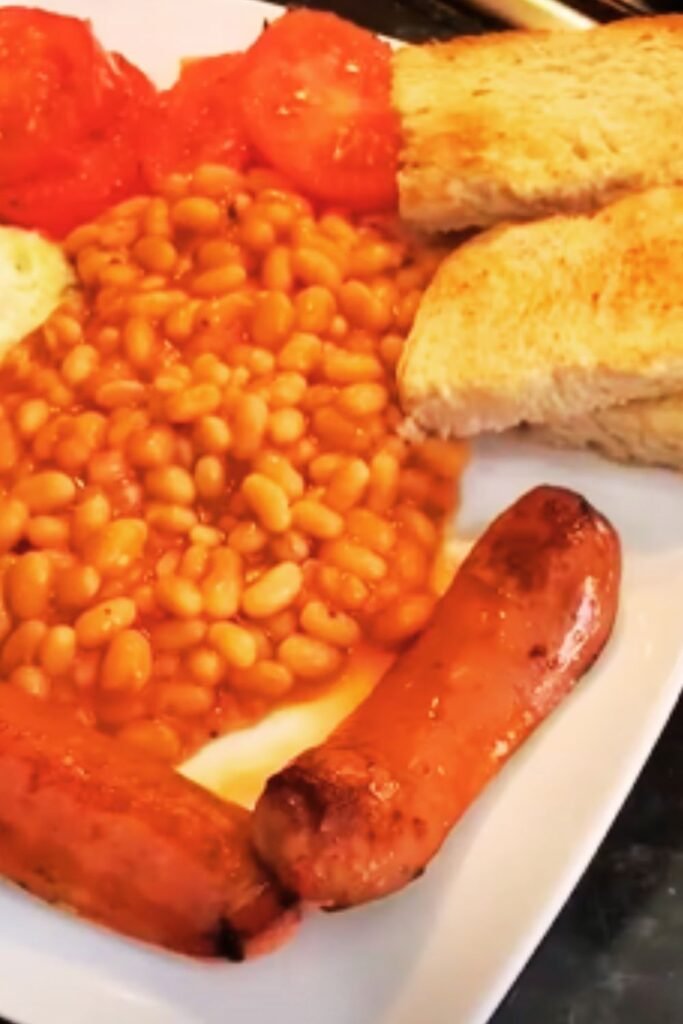There’s something magical about the sizzle of bacon, the rich aroma of freshly brewed tea, and the anticipation of that first bite of a perfectly runny egg yolk. Growing up in a small village just outside of Yorkshire, the Full English breakfast was our weekend ritual – a hearty tradition that brought the family together around the kitchen table. After years of perfecting my technique and sampling countless variations across the British Isles, I’m excited to share everything I know about creating the ultimate Full English breakfast experience right in your own home.
The Rich History Behind Britain’s Most Famous Breakfast
The Full English breakfast, affectionately known as a “fry-up” by locals, has been a cornerstone of British culinary tradition since the Victorian era. What began as a lavish display of wealth and abundance among the gentry in the 13th century gradually transformed into a hearty meal for the working class during the Industrial Revolution.
In the 1800s, as workers headed to factories and mines, they needed substantial fuel to power through physically demanding jobs. The Full English breakfast emerged as the perfect solution – calorie-dense, satisfying, and utilizing ingredients readily available on British farms.
Today, this iconic breakfast transcends class boundaries and has become a beloved national institution. You’ll find it served in humble cafes (often called “greasy spoons”), upscale hotels, and family kitchens across the United Kingdom. While regional variations exist – the Ulster Fry in Northern Ireland, the Full Scottish with its black pudding and tattie scones, or the Full Welsh featuring laverbread – they all share the same comforting essence that makes this breakfast so special.
Essential Components of an Authentic Full English
What exactly constitutes a “proper” Full English breakfast? While debates rage on about specific ingredients, most traditionalists agree on certain non-negotiable elements. Here’s what you’ll typically find on a classic Full English plate:
- Bacon: Back bacon (what Americans might call Canadian bacon) is traditional, though streaky bacon is increasingly popular.
- Sausages: High-quality pork sausages, often referred to as “bangers.”
- Eggs: Typically fried with runny yolks, though scrambled is an acceptable variation.
- Black Pudding: A blood sausage made with pork fat, oatmeal, and blood.
- Baked Beans: Haricot beans in a tomato sauce, almost always Heinz brand in Britain.
- Tomatoes: Either half a grilled fresh tomato or whole canned tomatoes.
- Mushrooms: Button mushrooms sautéed until golden brown.
- Fried Bread or Toast: Bread either fried in the residual fat from cooking or simply toasted.
Of course, regional variations and personal preferences might add or subtract items from this list. Some purists insist on including kidneys, while others might serve bubble and squeak (a potato and cabbage mixture) or hash browns alongside the standard components.
The Perfect Full English: A Step-by-Step Guide
Having prepared hundreds of Full English breakfasts over the years, I’ve developed a foolproof method that ensures everything arrives hot and perfectly cooked on the plate at the same time – which, let me tell you, is the trickiest part of mastering this meal!
Equipment You’ll Need
- Large frying pan (preferably cast iron)
- Small saucepan for beans
- Tongs and spatula
- Plates kept warm in the oven
The Traditional Recipe
Ingredients (serves 2):
- 4 high-quality pork sausages
- 4 slices of back bacon
- 2 slices of black pudding (about 1 cm thick)
- 2 large free-range eggs
- 6-8 button mushrooms, cleaned and halved
- 2 tomatoes, halved
- 1 small can (200g) Heinz baked beans
- 2 slices of bread (white or sourdough work best)
- Butter for frying
- Vegetable oil
- Salt and pepper to taste
Method:
- Preheat your oven to a low temperature (around 100°C/215°F) to keep plates and cooked items warm.
- Start with the sausages as they take the longest to cook. Heat a little oil in your frying pan over medium heat and add the sausages. Cook for about 15-20 minutes, turning occasionally until browned all over and thoroughly cooked.
- When the sausages are about halfway done, add the black pudding slices to the pan. They’ll need about 3-4 minutes on each side until crisp on the outside but still soft in the middle.
- Add the bacon to the pan. British back bacon is leaner than American streaky bacon and doesn’t need as long to cook – about 2-3 minutes per side until just crisped around the edges.
- Meanwhile, pour the beans into a small saucepan and heat gently over low heat, stirring occasionally. Don’t let them boil vigorously as they’ll dry out.
- Push the meat to one side of your pan and add the mushrooms, allowing them to cook in the flavorful fat released by the meat. Season with a pinch of salt and pepper.
- Add the tomato halves, cut-side down, to the pan. They need just a few minutes to soften and caramelize slightly.
- If your pan is becoming overcrowded, transfer the cooked items to an oven-proof plate and keep warm in the oven.
- For the fried bread, you can either toast the bread separately or fry it in the same pan. For authentic fried bread, push everything to the sides of the pan, add a small knob of butter, and fry the bread in the center until golden and crisp on both sides, absorbing the flavors from the pan.
- Finally, crack the eggs directly into the pan, spooning some of the hot fat over the whites to help them set while keeping the yolks runny. Season with a pinch of salt and pepper.
- Assemble your plate, arranging all elements beautifully, with the beans often served in a small separate ramekin by purists (to prevent them from “contaminating” the other items with sauce).
- Serve immediately with a pot of strong tea (English Breakfast, naturally) and perhaps a glass of fresh orange juice.

Nutritional Information and Calorie Breakdown
Let’s be honest – the Full English isn’t winning any awards for being dietetically balanced. However, it’s a meal meant to be savored occasionally rather than daily. Here’s a detailed breakdown of what you’re getting in a typical serving:
| Component | Calories | Protein | Fat | Carbs |
|---|---|---|---|---|
| 2 Pork Sausages | 330 | 13g | 28g | 10g |
| 2 Slices Back Bacon | 160 | 20g | 10g | 0g |
| 1 Slice Black Pudding | 150 | 6g | 11g | 8g |
| 1 Fried Egg | 90 | 6g | 7g | 0g |
| 1/2 Cup Baked Beans | 120 | 6g | 0.5g | 25g |
| 1 Grilled Tomato | 22 | 1g | 0.2g | 5g |
| 1/4 Cup Mushrooms | 15 | 1g | 0.2g | 2g |
| 1 Slice Fried Bread | 180 | 4g | 12g | 15g |
| Total | 1067 | 57g | 68.9g | 65g |
As you can see, a traditional Full English breakfast can easily exceed 1,000 calories – more than half the recommended daily caloric intake for many people. That said, it’s incredibly satisfying and will keep you fueled for hours, making it perfect for active days or special weekend indulgences.
Healthier Adaptations Without Sacrificing Flavor
If you’re watching your waistline but still craving that Full English experience, I’ve experimented with several modifications that preserve the essence while reducing the calorie count:
- Grill or bake the sausages and bacon instead of frying
- Use turkey or chicken sausages instead of pork
- Opt for poached or scrambled eggs (using minimal butter)
- Choose regular toasted wholegrain bread instead of fried bread
- Include extra grilled tomatoes and mushrooms to fill the plate
- Use reduced-sugar and salt baked beans
- Skip the black pudding or use a smaller portion
These swaps can bring the calorie count down to around 600-700 while still providing a satisfying breakfast experience.
| Modified Component | Original Calories | Modified Calories | Savings |
|---|---|---|---|
| Grilled Turkey Sausages (2) | 330 | 180 | 150 |
| Grilled Back Bacon (2 slices) | 160 | 120 | 40 |
| Poached Egg (1) | 90 | 70 | 20 |
| Wholegrain Toast (1 slice) | 180 | 90 | 90 |
| Reduced-Sugar Beans (1/2 cup) | 120 | 100 | 20 |
| Total Savings | 320 |
Regional Variations Across the British Isles
One of the joys of traveling throughout the UK is experiencing how each region puts its unique spin on the Full English breakfast. Here are some fascinating variations you might encounter:
Full Scottish Breakfast
The Scottish version typically includes:
- Lorne sausage (square sausage)
- Tattie scones (potato pancakes)
- Haggis
- Fruit pudding (sweet black pudding)
Ulster Fry (Northern Ireland)
This variation often features:
- Soda bread
- Potato bread
- No baked beans (traditionally)
Full Welsh Breakfast
In Wales, you might find:
- Laverbread (seaweed paste)
- Cockles
- Welsh cakes
Cornish Breakfast
In Cornwall, additions might include:
- Hog’s pudding (a type of sausage)
- Cornish sardines
- Saffron bread
These regional differences reflect local produce and cultural preferences, making breakfast exploration a delightful culinary adventure across the British Isles.

Perfect Pairings and Serving Suggestions
What you serve alongside your Full English is almost as important as the meal itself. Here are my time-tested recommendations:
Beverages
- Tea: A strong English Breakfast tea is the traditional choice, served with milk and optionally sugar.
- Coffee: If you prefer coffee, a robust filter coffee works better than delicate espresso-based drinks.
- Fresh Orange Juice: The acidity helps cut through the richness of the meal.
- Tomato Juice: Popular in hotels and with those seeking a savory start.
Condiments
- HP Sauce: This fruity, tamarind-based brown sauce is specifically designed for breakfast meats.
- Ketchup: A controversial but popular choice, especially with the younger generation.
- English Mustard: Adds a fiery kick to sausages.
- Marmalade: For spreading on any leftover toast.
Side Additions
- Bubble and Squeak: Leftover potatoes and cabbage fried together – a classic addition.
- Hash Browns: Not traditional but increasingly common.
- Kedgeree: Smoked fish, rice, and eggs make an upscale breakfast companion.
For a truly indulgent weekend experience, I love to serve fruit juice first, followed by the Full English with all the condiments on the side, and finishing with a rack of hot buttered toast with marmalade and a fresh pot of tea. It’s the kind of slow, conversational breakfast that turns into brunch and creates lasting memories.
Common Mistakes to Avoid
Through years of observation in kitchens across Britain, I’ve noticed several common pitfalls that can turn a potentially perfect breakfast into a disappointment:
- Cooking everything on high heat: This leads to burned exteriors and raw interiors, particularly with sausages. Patience and medium heat are your friends.
- Overcrowding the pan: This causes steaming rather than frying, resulting in soggy rather than crisp components.
- Poor timing: Having some items go cold while others are still cooking is a classic error. Use the warm oven technique mentioned earlier.
- Low-quality ingredients: The Full English showcases simple foods, so quality really matters. Invest in proper butcher’s sausages and dry-cured bacon.
- Cooking eggs too early: They take the least time and should be one of the final items prepared.
- Boiling the beans: This makes them dry and unpleasant. Gentle heating is all they need.
- Forgetting to warm the plates: Nothing ruins a breakfast faster than food going cold within minutes of serving.
Avoid these mistakes, and you’ll be on your way to breakfast perfection!
The Cultural Significance of the Full English
The Full English breakfast isn’t merely a meal; it’s a cultural institution that has permeated British identity. It represents hospitality, comfort, and a certain pragmatic approach to life that is quintessentially British.
In literature and film, the Full English often makes an appearance as a symbol of normalcy or as comfort after chaos. From James Bond novels to scenes in “Hot Fuzz,” this iconic meal represents a return to order and tradition.
There’s also something deeply democratic about the Full English. While ingredients may vary in quality from a transport cafe to a five-star hotel, the basic composition remains remarkably consistent across social and economic boundaries. Whether you’re a tradesperson or a business executive, chances are you share an appreciation for this hearty start to the day.
In my travels around Britain, I’ve found that asking locals about their preferred Full English components often reveals not just personal taste but regional pride and family traditions. Some insist that black pudding is essential, while others would never allow their bacon to touch their beans. These passionate debates are part of what makes British food culture so rich and engaging.

Frequently Asked Questions
Q: What’s the difference between a Full English and a Full Irish breakfast?
The Full Irish typically includes white pudding (similar to black pudding but without the blood) in addition to most Full English components. You might also find soda bread on the side.
Q: Is it acceptable to include hash browns in a Full English?
While purists might argue that hash browns are an American import, they’ve become increasingly common in modern Full English breakfasts, especially in restaurants and hotels. Traditional home-cooked versions are less likely to include them.
Q: How do I make vegetarian or vegan versions of a Full English?
For vegetarians, substitute meat items with vegetarian sausages, halloumi cheese, and extra grilled vegetables. Vegans can use plant-based sausages, tofu scramble instead of eggs, and avocado for richness. Many brands now make vegan black pudding alternatives as well.
Q: Why is black pudding controversial, and is it essential?
Black pudding (made with pig’s blood) can be polarizing due to both its ingredients and its strong flavor. While traditionalists consider it essential, many people enjoy Full English without it. In parts of northern England and Scotland, it’s considered more integral than in the south.
Q: Can I prepare components ahead of time for a large group?
Yes! For serving a crowd, you can pre-cook sausages and bacon in the oven until almost done, then finish them in the pan just before serving. Beans can be kept warm in a slow cooker, and eggs should always be cooked fresh to order.
Q: What type of sausage is best for a Full English?
Cumberland sausages are a popular choice due to their herby flavor and coarse texture, but any high-quality pork sausage with at least 80% meat content will work well. Look for traditional butcher’s sausages rather than mass-produced varieties for best results.
My Personal Reflections on a Lifetime of Full English Breakfasts
Perhaps it’s the rose-tinted glasses of nostalgia, but I truly believe that a properly executed Full English breakfast represents one of the finest culinary traditions to emerge from the British Isles. It’s honest food – unpretentious, satisfying, and deeply connected to the land and its people.
Throughout my life, the Full English has marked significant moments – lazy weekend mornings with family, recovery meals after celebration nights, fortifying starts to hiking trips in the Lake District, and welcome comforts in unfamiliar B&Bs across the country.
What I appreciate most about this tradition is its ability to bring people together. There’s something about the shared experience of a hearty breakfast that encourages conversation and connection. In an increasingly fragmented world, these moments of togetherness around the breakfast table feel more precious than ever.
Whether you’re a lifelong devotee or new to the Full English experience, I hope this guide inspires you to create your own breakfast tradition. Experiment with regional variations, adjust components to suit your personal taste, but always honor the spirit of generosity and comfort that makes this meal so beloved.
After all, few problems in life seem quite as daunting after a proper Full English breakfast and a good cup of tea. And perhaps that’s its greatest gift – not just nourishment for the body, but for the soul as well.


